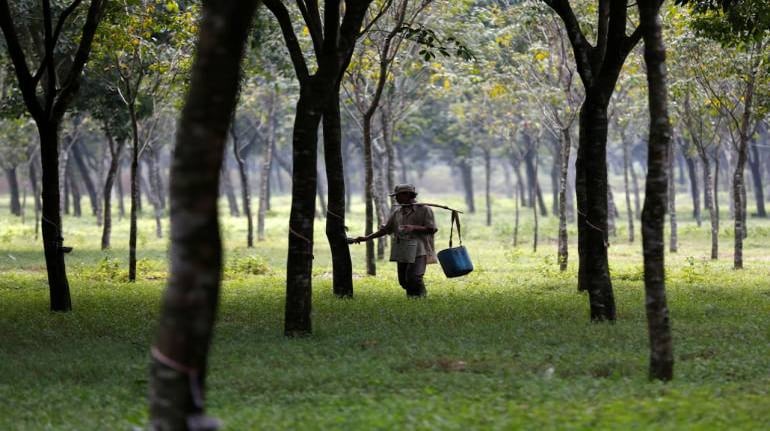



Indian natural rubber prices have sunk to a two-year low on weak demand prospects and higher arrivals, raising concerns of waning tapping interest among growers in the current peak harvest season.
The price of the RSS-4 variety used by the tyre industry is at Rs 137.5 per kg, a fall of 8 percent in the last couple of months. The decline was heavier this week on reports of the spread of the new variant of COVID-19 in China.
Last time prices touched this level was in October 2020 when the economy was recovering from the first COVID-19 lockdown. Challenging conditions in the international markets have also aided the fall in rubber prices.
“The offtake by the tyre sector is weak, and this is the peak tapping season. Rubber prices had risen very high after the pandemic subsided, and are now seeing a correction,” said K N Raghavan, Executive Director (ED), Rubber Board.
Also Read | India eyes quality control measures for rubber, cement industries - Report
The tyre industry’s expectation of a boost in demand in the third quarter of the fiscal year has not materialised and vehicle sales continue to be moderate. They are now expecting a pick-up only in the last quarter.
International rubber prices have been ruling low in the past few months because of excess supply and the spread of COVID-19 in China, the largest consumer. But there is no cause for undue worry, says rubber analyst and expert Jom Jacob.
“China is relaxing its safeguards on COVID-19 and there is an easing of concern over the demand outlook of natural rubber (NR) in China. Businesses and various economic activities are reportedly in the process of returning to normal by managing the chaos created by the abrupt lifting of restrictions,” he said.
Besides, the price support scheme of the Kerala government has ensured that small growers, who account for the majority of rubber growers in the state, get a price of Rs 170 per kg. This had sustained their interest in tapping even at low prices. It would have led to more tapping of rubber in the current season if payments from the government were promptly made, since the difference vis-à-vis the market price is now Rs 32 per kg.
But only about Rs 1 crore has been released so far this year by the government, which is hard up for funds. “As a result of this and the downturn in demand, tapping is subdued,” Raghavan said.
The Rubber Board had targeted a 10 percent rise in production in financial year 2022-23 at 8.5 lakh tonnes. Raghavan said the expectation is around eight lakh tonnes now. In April-October 2022, production witnessed a 10 percent rise year-on-year (YoY) at 4.27 lakh tonnes, while consumption climbed by 7.5 percent to 7.88 lakh tonnes in the same period. Growth, however, has slumped after October when the peak season started.
Last year, consumption had increased at a higher rate of 13 percent compared to production which grew by over 8 percent. Consumption saw a new high of 12.38 lakh tonnes in 2021-22. But this year, the trend seems to have reversed.
Things are not all that bright at the production front with climatic changes affecting output. “As a result of heavy rains in the last two months there has been a lot of leaf fall, which has resulted in lower yields. Given the situation, the peak tapping season may not extend beyond January,” said George Valy, President of the Indian Rubber Dealers Federation.
According to him, higher production in the north eastern region, which is the second-biggest rubber producing region after Kerala, and higher imports have contributed to the decline in prices. Imports have surged by around 16 percent to 329,277 tonnes in April-October 2022, compared to the same period last year.
Globally, the easing of adverse weather conditions in Thailand, the biggest rubber producer and onset of lean season in Vietnam and China leading to a seasonal fall in world supply, can have only a limited impact on prices on account of two factors, said Jom Jacob. “First, there would be excess stock in the market as the world output stayed considerably above the supply for the past five months. Secondly, global demand prospects are weighed down by the recent spike in COVID-19 infections in China and the fresh concerns about a global economic recession.”
Latex prices are likely to exhibit a relatively higher momentum largely in view of the increased demand from glove manufacturing companies amid surging COVID-19 infection in China, he added. Dry latex prices in India, after a 35 percent fall to Rs 85 per kg, have now improved to around Rs 89, which may bring cheer to the rubber farmers. At the peak of the pandemic there was more demand for latex over rubber sheets, since the glove industry was on an overdrive.
Discover the latest Business News, Sensex, and Nifty updates. Obtain Personal Finance insights, tax queries, and expert opinions on Moneycontrol or download the Moneycontrol App to stay updated!
Find the best of Al News in one place, specially curated for you every weekend.
Stay on top of the latest tech trends and biggest startup news.